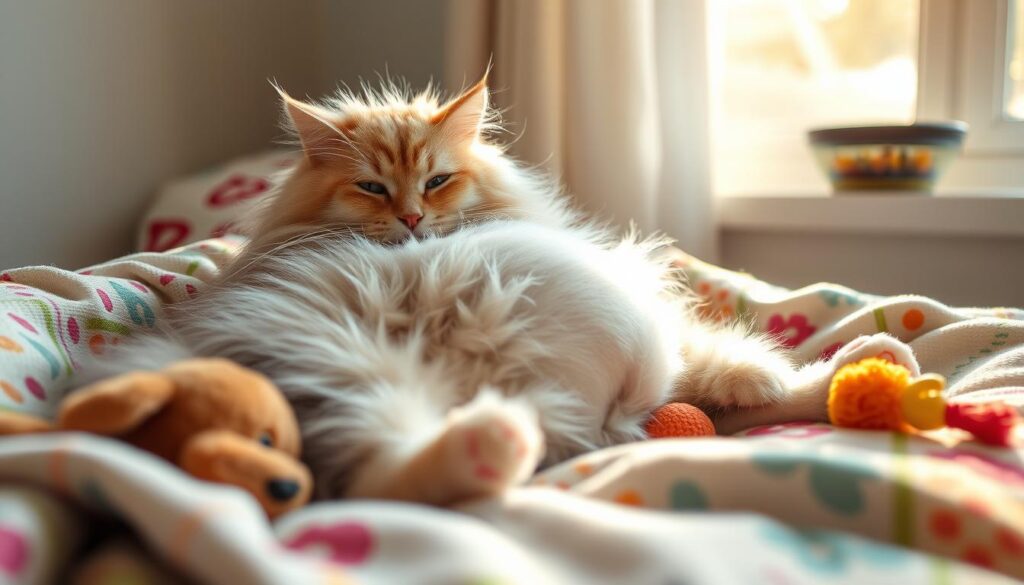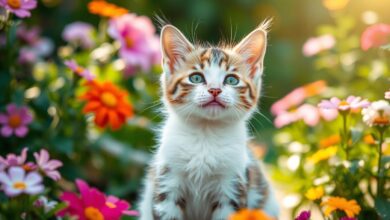Understanding Pregnant Cat Behavior: What to Expect

Pregnant Cat Behavior can change noticeably during pregnancy. As a pet owner, you may notice your cat becoming more affectionate and seeking extra attention, while others might prefer solitude. Pregnancy can cause stress in your cat, leading to shifts in her usual behavior. It’s important to monitor her closely and ensure her environment is calm and comfortable during this time.
Looking for signs of pregnancy, like weight gain or changes in appetite, can help you get ready for the kittens. Knowing how your pregnant cat behaves is key to supporting her on this special journey.
Key Takeaways
- Pregnant cats may exhibit behavioral changes, including increased affection or desire for solitude.
- Physical signs of pregnancy in cats include weight gain, changes in appetite, and ‘pinking up’ of the nipples.
- Providing a calm, comfortable environment is essential for supporting your pregnant cat.
- Observing your cat’s behavior and recognizing the signs of pregnancy can help you prepare for the arrival of her kittens.
- Regular veterinary check-ups are crucial for monitoring the health of a pregnant cat and her growing litter.

Signs of Pregnancy in Cats
Finding out if a cat is pregnant can be tricky, especially early on. But, there are clear signs that show when a cat is expecting. Let’s look at the early and later signs of cat pregnancy.
Early Signs of Cat Pregnancy
One of the first signs is “pinking up” of the nipples. This happens around 16-20 days into pregnancy. The nipples get bigger and turn reddish. Also, a pregnant cat may groom her belly and the area under her tail more. She’s getting ready to nurse her kittens.
Later Signs of Cat Pregnancy
As pregnancy goes on, the signs get clearer. Around the last 20 days, a cat’s belly will look bigger. Her nipples and breast will also swell. She might look for places to nest and give birth, showing nesting behaviors like scratching and circling.
Cat pregnancy can last between 63 to 67 days. It can be as short as 61 days or as long as 72 days. Vets can confirm pregnancy through palpation, ultrasound, X-rays, and pregnancy tests. They can also tell how many kittens are coming.
| Pregnancy Milestone | Timeline |
|---|---|
| Conception | Day 0 |
| Nipple Changes (“Pinking Up”) | Days 16-20 |
| Visible Belly Distension | Last 20 Days |
| Average Gestation Period | 63-67 Days |
Knowing the early and later signs of cat pregnancy helps owners prepare. They can give the best care and support during this special time.
Stages of Cat Pregnancy
The cat gestation period is about two months, averaging 63-65 days. This time can be split into three trimesters, each lasting about 20 days.
In the first trimester (days 1-21), owners might not see big changes in their pregnant cat. But, in the second trimester (days 21-42), signs like a bigger belly and changes in behavior become clear.
The third trimester (days 42-63) is when changes are most obvious. Cats show a swollen belly, bigger nipples, and a big appetite.
| Trimester | Duration (days) | Typical Changes |
|---|---|---|
| First | 1-21 | Little to no visible changes |
| Second | 21-42 | Larger belly, behavioral changes |
| Third | 42-63 | Swollen belly, increased nipple/breast changes, increased appetite |
Keep in mind, cat pregnancies can vary. Some cats might give birth earlier or later than the average 63-65 days. Watching your cat’s health and changes closely is key for a healthy birth and kitten growth.

Caring for a Pregnant Cat
Pregnant cats need special care for their health. They should have a quiet, comfy spot at home. Pregnant cats need a high-calorie diet to support the growth of healthy kittens. They should start eating this diet by the end of the first month.
Diet for a Pregnant Cat
Feed a pregnant cat high-quality kitten food for extra nutrients. Pregnant cats’ food intake may increase by 70-85% during the third trimester, requiring a significant nutritional adjustment. Don’t overfeed them in the early weeks. Start with kitten food slowly and watch their weight.
Vaccinations and Parasite Prevention
Cats should get vaccinated before they get pregnant. This helps prevent illnesses and birth defects. Vaccinations are generally not recommended during pregnancy, as they may have adverse effects on kitten development, with certain types of rabies vaccines potentially being an exception. Keep up with parasite prevention, but use safe products.
| Statistic | Value |
|---|---|
| Pregnant cats’ food intake increase during third trimester | 70-85% |
| Average litter size for pregnant cats | 4-6 kittens |
| Cats reach sexual maturity at age | 4 months |
| Typical duration of cat pregnancy | 63 days (9 weeks) |
“Regular veterinary checkups during a cat’s pregnancy are recommended, with vet visits helping to identify any potential complications early on.”
Preparing for Labor and Delivery
As your cat’s last trimester approaches, it’s key to set up a nesting area. A good birthing nest lets you watch over your cat and kittens. You might notice changes in your cat’s behavior, like not eating and scratching at the nest.
Signs of Impending Labor
Signs show your cat’s labor is near. Look for a drop in body temperature to 98-99 degrees Fahrenheit, 24 hours before birth. Your cat might also become clingy, pace, and lick her belly and genital area. A loss of appetite is common too.
Complications like dystocia can happen during labor. Keep emergency items ready, like a bulb syringe and towels. Also, have your vet’s number and a cat carrier on hand. Talk to your vet weeks before the expected birth date to plan for any issues.
| Statistic | Value |
|---|---|
| Typical Gestation Period | 58 to 70 days |
| Normal Body Temperature before Labor | 101 to 102.5 degrees Fahrenheit |
| Body Temperature 24 Hours before Labor | 98 to 99 degrees Fahrenheit |
| Stage I Labor Duration | 6 to 12 hours |
| Time for First Kitten Delivery | 1 to 2 hours from onset of contractions |
Keep a close eye on your cat during labor. Be ready to help if needed. Knowing the signs and having the right supplies can make delivery safe for your cat and kittens.

Pregnant Cat Behavior
As your cat’s pregnancy advances, you’ll see many changes in her behavior. Knowing these changes helps you make a cozy home for her. This ensures she feels safe and comfortable during this special time.
Pregnant cats often start nesting more. They look for quiet, cozy spots to get ready for their kittens. They might get very protective of these areas. They might even get upset if others try to join them.
Changes in eating habits are also common. Some cats might eat more, while others might pickier or refuse food. It’s crucial to feed them a balanced, nutritious diet. This supports their health and the growth of their kittens.
Aggression can also show up during pregnancy. It might be due to hormonal shifts, discomfort, or feeling scared. Giving your cat a quiet, safe spot helps reduce stress. This can prevent aggressive behavior.
| Behavior | Description |
|---|---|
| Nesting | Pregnant cats may seek out cozy, quiet spaces to prepare for the arrival of their kittens. |
| Eating Habits | Pregnant cats may have increased appetites or become more selective with their food choices. |
| Aggression | Pregnant cats may exhibit aggressive behaviors due to hormonal changes, discomfort, or feeling threatened. |
Understanding pregnant cat behavior lets you support your cat during this time. By noticing and responding to these changes, you can make her pregnancy more comfortable. This benefits both you and your cat.
“Pregnant cats may become more possessive of their nesting areas and can even exhibit aggression towards other pets or family members who try to enter their space.”
Postpartum Care for Cats
Caring for a new mother cat and her kittens is very important. Make sure the kittens are dry and their noses and mouths are clear. Clean any soiled linen in the nesting box without disturbing the family.
Watch from a distance to see if the kittens are nursing. They should start almost right after birth.
Give the nursing queen plenty of food and fresh water. Watch her for any signs of stress or illness that need vet help. Cats can face health issues like inflamed mammary glands or loss of milk production soon after birth.
Make a quiet, safe space for the mother cat and her kittens. Handle the kittens little to keep the mother’s trust. Cats start showing maternal instincts before birth, like grooming and protecting their young.
The mother cat will nurse her kittens a lot during this time. They need high-quality kitten food to grow well. Sometimes, the mother might need help caring for her kittens.
It’s key to socialize kittens early for their future happiness. But, start gentle socialization from the second week. Taking good care of the mother cat and her kittens is essential for their health and growth.
“Proper postpartum care for cats is crucial for the well-being of the mother and her newborn kittens.”
Conclusion
Caring for a pregnant cat can be both rewarding and challenging. Understanding her behavior and following a good guide can make this time easier for her. You can help make her pregnancy as comfortable as possible.
This guide has given you the tools to support your cat at every stage. It’s important to ensure she gets the right food, exercise, and vet care. Also, be aware of her changing social behaviors.
Every pregnant cat is different. Paying attention to her unique needs and preferences is key. With the right care and commitment, you can help your cat through this important time with ease.
FAQ
What are the early signs of pregnancy in cats?
Early signs of cat pregnancy include nipple changes, known as ‘pinking up.’ This happens about 16-20 days into pregnancy.
How can I tell if my cat is in the later stages of pregnancy?
In the last 20 days, a cat’s belly will look distended. Their nipples and breast tissue will swell. Queens may groom their belly and look for places to nest or give birth.
What is the typical cat gestation period?
The cat gestation period is about two months, averaging 63-65 days. It’s roughly divided into three trimesters of 20 days each.
What special requirements do pregnant cats have?
Pregnant cats need a quiet, comfy spot at home. They also need a high-calorie diet for healthy kittens. Vaccinations before pregnancy help prevent illnesses and birth defects.
How can I prepare for my cat’s labor and delivery?
As your cat’s last trimester starts, give her a spot to nest. Look for signs like a drop in body temperature, clingy behavior, pacing, and licking at her belly and genital area.
How might a pregnant cat’s behavior change?
Pregnant cats may nest, eat differently, and show aggression. Aggression can be due to hormonal changes, discomfort, or feeling threatened.
What should I do after my cat gives birth?
After all kittens are born, make sure they’re dry and their airways are clear. Watch from afar to see if they’re nursing. Give the queen plenty of food and water, and watch for signs of stress or illness.





